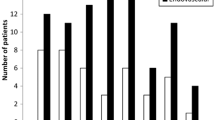Summary
In the last 3,5 years (up to August 1988) out of 450 patients with surgically treated intracranial aneurysms in 100 cases (22%) acute surgery was performed (up to 72 h after SAH). Patients in grade I-III (WFNS scale) were operated upon. In all the cases there were supratentorial aneurysms. CSF drainage during the operation was used routinely and nimodipine topically, in intravenous infusion and orally was applied. In all the cases, but one, the aneurysms was clipped. Follow-up — 1 year. Assessment of the results was done using the Glasgow Outcome Scale (GOS). Full recovery was obtained in 78 patients and further 5 patients are independent. There were 14 deaths, in 7 patients due to postoperative vasospasm. Symptomatic ischaemia developed in 25 patients, however, in 15 of them it was fully reversible, due to the possibility of aggressive antivasospastic treatment (hypervolaemia, induced arterial hypertension). The relatively worse results were obtained in patients with chronic arterial hypertension.
Similar content being viewed by others
References
Auer LM, Heppner F, Symon L (eds) (1982) Aneurysm surgery in the acute stage, Proceedings of the symposium Graz, July 19–21, 1981. Acta Neurochir (Wien) 63: 1–306
Auer LM (1984) Acute operation and preventive Nimodipine improve outcome in patients with ruptured cerebral aneurysms. Neurosurgery 15: 57–66
Auer LM, Suzuki A, Yasai N, Ito Z (1984) Intraoperative topical nimodipine after aneurysms clipping. Neurochirurgia (Stuttg) 27: 36–38
Auer LM, Brandt L, Ebeling Uet al (1986) Nimodipine and early aneurysm operation in good condition SAH patients. Acta Neurochir (Wien) 82: 7–13
Bolander HG, Kourtopoulos H, West KA (1984) Retrospective analysis of 162 consecutive cases of ruptured intracranial aneurysms. Total mortality and early surgery. Acta Neurochir (Wien) 70: 31–41
Brandt L, Ljunggren B, Anderson KEet al (1982) Studies on cerebral vasospasm. In: Brock M (ed) Modern neurosurgery, Vol. 1. Springer, Berlin Heidelberg New York, pp 383–395
Flamm E (1983) Late surgery versus early surgery. In: Battye R (ed) Calcium antagonists: possible therapeutic use in neurosurgery. Proceedings of a workshop. Dorado Beach, Puerto Rico, June 10–11, pp 33–34
Gilsbach JM, Harders AG, Eggert HR, Hornyak ME (1988) Early aneurysm surgery: a 7 years clinical practice report. Acta Neurochir (Wien) 90: 91–102
Gurusinghe NT, Richardson AE (1984) The value of computerized tomography in aneurysmal subarachnoid hemorrhage. The concept of the CT score. J Neurosurg 60: 763–770
Kassel NF, Drake CG (1982) Timing of aneurysm surgery. Neurosurgery 10: 514–519
Kassel NF (1983) The natural history and treatment outcome of SAH: comments derived from the National Cooperative Aneurysm Study. In: Battye R (ed) Calcium antagonists: possible therapeutic use in neurosurgery. Proceedings of a workshop. Dorado Beach, Puerto Rico, June 10–11, pp 24–29
Ljunggren B, Brandt L, Kaegstrom E, Sundberg G (1981) Results of early operations for ruptured aneurysms. J Neurosurg 54: 473–479
Ljunggren B, Saeveland H, Brandt L, Zygmunt S (1985) Early operation and overall outcome in aneurysmal hemorrhage. J Neurosurg 62: 547–551
Mizyukami M, Kawase T, Usami Tet al (1982) Prevention of vasospasm by early operation with removal of subarachnoid blood. Neurosurgery 10: 301–307
Philippon J, Grob R, Dagreou Fet al (1986) Prevention of vasospasm in subarachnoid hemorrhage. A controlled study with nimodipine. Acta Neurochir (Wien) 82: 110–114
Sundt TM Jr, Kobayashi S, Fode NC, Whisnant JP (1982) Results and complications of surgical management of 809 intracranial aneurysms in 722 cases. J Neurosurg 56: 753–765
Taneda M (1982) Effect of early operation for ruptured aneurysms on prevention of delayed ischemic symptoms. J Neurosurg 57: 622–628
Taneda M (1982) The significance of early operation in the management of ruptured intracranial aneurysms-an analysis of 251 cases hospitalized within 24 hours after subarachnoid haemorrhage. Acta Neurochir (Wien) 63: 201–208
Vapalahti M, Ljunggren B, Saeveland Het al (1984) Early aneurysm operation and outcome in two remote Scandinavian populations. J Neurosurg 60: 1160–1162
Weir B, Aronyk K (1981) Management mortality and the timing of surgery for supratentorial aneurysms. J Neurosurg 54: 146–150
Yamamoto J, Hara M, Ogura Ket al (1983) Early operation for ruptured intracranial aneurysms: comparative study with computed tomography. Neurosurgery 12: 1969–1974
Author information
Authors and Affiliations
Rights and permissions
About this article
Cite this article
Bidziński, J., Marchel, A. & Pastuszko, M. Acute surgery in intracranial aneurysms. Acta neurochir 103, 1–4 (1990). https://doi.org/10.1007/BF01420184
Issue Date:
DOI: https://doi.org/10.1007/BF01420184




